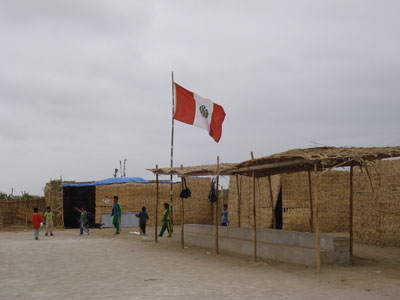INFORMATIVE BULLETIN
UNICEF’s Response To The Earthquake Emergency in Peru

Foto: © UNICEF-TACRO
On the night of August 15, 2007, a powerful earthquake measuring 7.9 on the Richter magnitude scale struck the Peruvian coasts, with a particular strong impact in Ica department. The damages were extensive: houses, hospitals, churches, schools and government buildings were destroyed in the city of Pisco, and buildings were severely damaged in the cities of Chincha, Ica and Cañete. The official death toll was 519 and 1,291 people were injured.
UNICEF’s initial humanitarian response to the emergency in Pisco, Chicha and Ica lasted four months (August-December, 2007) and focused mainly on human lives, basic needs and the rapid recovery of people, institutions and territories. However, UNICEF continued to work through June 2009, in order to build the capacity of local and regional institutions, and contribute to their early recovery.
The chart below reflects the findings of a preliminary damage assessment in the education sector:
The earthquake completely destroyed a total of 643 classrooms.
School activities in the region were suspended midyear due to the damage caused by the earthquake. The damage in the education sector exceeded the emergency response capacity of the Ministry of Education. Coupled with the lack of coordination between education authorities at the local, regional, and national levels, this hampered efforts to find specific and effective solutions to the problems caused by the emergency.
Given the considerable level of damage, emergency shelters were set up for families that had lost their houses. The large number of families in these shelters sharing tents and common areas left children and women exposed to violence and sexual abuse. In addition, children affected by the earthquake experienced mental health problems with symptoms such as sadness, fear, anxiety and insomnia.
For these reasons, UNICEF interventions focused on four priority areas in order to provide comprehensive services to children and teenagers:
- Early childhood development
- Children protection
- Water and sanitation
- Education
In order to restore education services as soon as possible, UNICEF launched a Back to School [“Regreso a la escuela”] strategy divided into several priorities and phases geared towards improving preparedness for future disasters.
The goal of the strategy was to ensure the right to education in emergency situations through access to education in temporary classrooms, where students may continue their normal activities in a safe environment until new facilities are built. The campaign also aimed to ensure that schools were rehabilitated or repaired promptly to ensure the safety of teachers and students.
The “back to school” campaigns were no easy task. Parents, teachers, children and teenagers put up strong resistance, not only because of the physical destruction of many education centers, but also out of fear and distrust.
As a result of the destruction in these cities, children and teenagers recycled metal waste to contribute to their family income. In view of this problem, awareness activities targeting parents were intensified to encourage them to allow their children to return to school.
Activities in the fields of education, humanitarian response and emergency early recovery focused on:
- Government assistance to restore educational services and strengthen its management capacity at the central, regional and local levels.
- Ongoing technical assistance to the Regional Education Bureau and its offices in Ica, Chicha and Pisco.
- Rapid assessments of school infrastructure. Three engineers were contracted for this purpose.
- Implementation of a communications strategy to support the “back to school” campaigns.
- Ensuring access to school supplies and educational materials. School kits were provided to 12,000 students, and educational materials to 400 teachers.
- Ensuring the access of children and youth to teachers willing to respond to emergency education needs and trained in how to navigate emotional issues in the classroom.
- Support for the adaptation of curricula and related educational activities.
- Construction of 304 temporary classrooms (tents and classrooms with straw mats), which made it possible for 34,000 students to go back to school and finish the school year.
- Construction and restoration of bathroom facilities in 52 education centers.
The following outcomes are anticipated in the framework of the current education strategy, the post-emergency phase, and capacity-building and networking efforts:
- The education sector will be strengthened at the national and local levels in the areas of disaster risk management and prevention and preparedness for emergency situations, in order to contribute to reducing children’s vulnerability.
- The Ministry of Education will have conducted a review of its emergency response plan, based on the lessons learned from the response to the 2007 earthquake.
- The educational services developed for emergency response purposes will be made a priority in the region.
- Disaster risk reduction will have been incorporated into school curricula, with materials available for teachers, students and parents.
- Disaster risk management and contingency plans will have been designed and implemented in schools located in priority areas.
Several lessons were gleaned from the 2007 earthquake in Ica. Interventions must be directed towards comprehensive services for children and teenagers affected by emergency situations. Also, comprehensive services must be made available to children under three years of age and efforts must be made to prevent violence against children. Interventions must also ensure access to safe water and basic sanitation services, and offer social and emotional support to those emotionally traumatized by the human and material losses they have experienced.
The emergency also gave us the opportunity to observe the altruism, solidarity and courage of the affected populations and of those who collaborated in the crisis. This is irrefutable proof that every crisis is also an opportunity to learn and reinforce lessons with a view towards the general well-being and integral development of the population. To capitalize on these opportunities and extract their lessons, it is important to act using the best tools available for reconstruction efforts and the psycho-affective recovery of all individuals.
Contact:
José Vásquez
Emergency Coordinator, UNICEF/Peru
jevasquez57@yahoo.es





